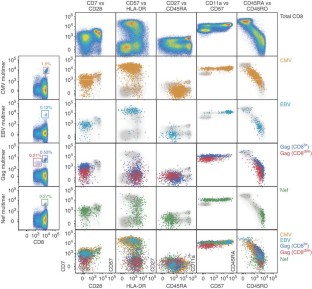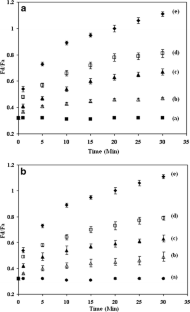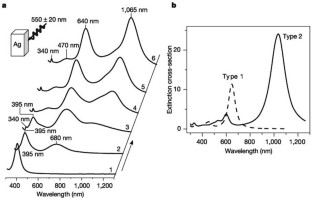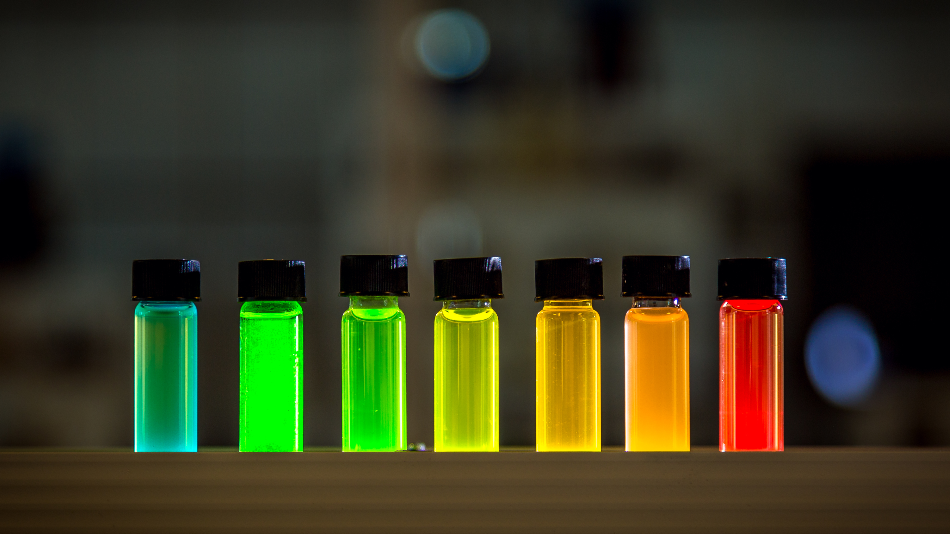44 semiconductor nanocrystals as fluorescent biological labels
› topics › agricultural-andQuantum Dot - an overview | ScienceDirect Topics QDs are colloidal fluorescent semiconductor nanocrystals (2–10 nm) with narrow emission and a broad range of absorption bands. This material is predominantly used in fabricating imaging probes [68]. The central core of QDs consists of combinations of elements from groups II–VI of the periodic system (CdSe, CdTe, CdS, PbSe, ZnS, and ZnSe) or ... › panoramic › indexPharmaCircle This website uses cookies to help provide you with the best possible online experience. Please read our Terms & Conditions and Privacy Policy for information about ...
Semiconductor nanocrystals as fluorescent biological labels. Semiconductor nanocrystals were prepared for use as fluorescent probes in biological staining and diagnostics. Compared with conventional fluorophores, the nanocrystals have a narrow, tunable, symmetric emission spectrum and are photochemically stable.

Semiconductor nanocrystals as fluorescent biological labels
Semiconductor nanocrystals as fluorescent biological labels. - Abstract ... Semiconductor nanocrystals were prepared for use as fluorescent probes in biological staining and diagnostics. Compared with conventional fluorophores, the nanocrystals have a narrow, tunable, symmetric emission spectrum and are photochemically stable. Semiconductor nanocrystals for biological imaging - ScienceDirect Semiconductor nanocrystals (see glossary), also called quantum dots (QDs), are a new class of fluorescent biological labels. Originating from quantum confinement (see glossary) of electrons and holes within the nanocrystal core material, the fluorescence from QDs is unique compared with that from traditional organic fluorophores. For example ... Semiconductor Nanocrystals as Fluorescent Biological Labels University of California, Los Angeles Abstract and Figures Semiconductor nanocrystals were prepared for use as fluorescent probes in biological staining and diagnostics. Compared with conventional...
Semiconductor nanocrystals as fluorescent biological labels. PDF Ovid: Bruchez: Science, Volume 281(5385).September 25 ... - ResearchGate Semiconductor nanocrystals were prepared for use as fluorescent probes inbiological staining and diagnostics.Compared with conventional fluorophores, thenanocrystals have a narrow, iopscience.iop.org › journal › 2050-6120Methods and Applications in Fluorescence - IOPscience These encompass biological, medical, chemical, material and nano research using experimental, theoretical and data analysis methods, which span probes, spectroscopy, imaging and microscopy. The journal publishes original research articles, topical reviews, tutorials, technical notes and editorial perspectives. 3C-SiC Nanocrystals as Fluorescent Biological Labels Silicon carbide nanocrystals are water-soluble, chemically inert, and highly fluorescent, and they may be idealas biological labels. After the uptake of3C-SiC nanocrystals, human fetal osteoblast (hFOB) cells exhibit brightgreen-yellow fluorescence (see image).The nanoparticles show high resistanceagainst photobleaching with no significant ... › topics › engineeringQuantum Confinement Effect - an overview | ScienceDirect Topics In Nanostructured Semiconductor Oxides for the Next Generation of Electronics and Functional Devices, 2014. 6.5.2 PbS and PbSe quantum dot layers. It has been reported that the quantum confinement effect contributes to the extension of the photovoltaic potential of low-bandgap semiconductors such as PbS or PbSe (bandgaps are about 0.41 157 and 0.27 eV 158 for PbS and PbSe, respectively) by ...
Semiconductor Nanocrystals as Fluorescent Biological Labels Semiconductor Nanocrystals as Fluorescent Biological Labels REPORTS SCLM origin of these peridotites is the close spatial proximity of mantle with such widely varying extraction ages, when every other geochemical aspect of the peridotites sug- gests they are petrogenetically related (9, 10). These Os isotope data indicate that unusu- Semiconductor Nanocrystals as Fluorescent Biological Labels - NASA/ADS adshelp[at]cfa.harvard.edu The ADS is operated by the Smithsonian Astrophysical Observatory under NASA Cooperative Agreement NNX16AC86A PDF Semiconductor Nanocrystals as Fluorescent Biological Labels Semiconductor nanocrystals were prepared for use as ßuorescent probes in biological staining and diagnostics. Compared with conventional ßuorophores, the nanocrystals have a narrow, tunable, symmetric emission spectrum and are photochemically stable. Semiconductor nanocrystals as fluorescent biological labels Semiconductor nanocrystals as fluorescent biological labels Author BRUCHEZ, M. JR 1 2; MORONNE, M 3; GIN, P 3; WEISS, S 4; ALIVISATOS, A. P 1 2 [1] Department of Chemistry, University of California, Berkeley, CA 94720, United States [2] Materials Sciences Division, Lawrence Berkeley National Laboratory (LBNL), 1 Cyclotron Road, Berkeley, CA 94720, United States [3] Life Sciences Division, LBNL ...
Semiconductor nanocrystals and fluorescence microscopy in biological ... This work presents and discuss some features concerning the use of fluorescence microscopy for the analysis of living biological samples labeled with fluorescent colloidal semiconductor nanocrystals in the quantum confinement regimen (quantum dots). ... Quantum dots as fluorescent bio-labels in cancer diagnostic. › pmc › articlesBiomedical Applications of Zinc Oxide Nanomaterials - PMC ZnO is a wide band gap semiconductor (3.37 eV) with high exciton binding energy (60 meV), which leads to efficient excitonic blue and near-UV emission . The use of ZnO in sunscreens has been approved by the food and drug administration (FDA) due to its stability and inherent capability to absorb UV irradiation. Direct conjugation of semiconductor nanocrystals to a globular protein ... In this Article, we study the development of semiconductor nanocrystals (quantum dots of average diameter less than 2 nm) directly conjugated to a transporter protein human serum albumin (HSA) as fluorescent biological labels. Förster resonance energy transfer (FRET) from the amino acid tryptophan ( … Semiconductor Quantum Rods as Single Molecule Fluorescent Biological Labels In this paper, we report the development of rod-shaped semiconductor nanocrystals (quantum rods) as fluorescent biological labels. Water-soluble biocompatible quantum rods have been prepared by surface silanization and applied for nonspecific cell tracking as well as specific cellular targeting.

Quantum dot semiconductor nanocrystals for immunophenotyping by polychromatic flow cytometry ...
› pmc › articlesGold nanoparticles: Opportunities and Challenges in Nanomedicine The active application of AuNPs center primarily on two key aspects that make them apt for use in biological systems: 1) the intrinsic properties of the gold core and 2) the ability to tailor the functionality of the surface. In general, current applications of nanoparticles have focused primarily on the detection of biological molecules or events.
Semiconductor nanocrystals as fluorescent biological labels Semiconductor nanocrystals as fluorescent biological labels (PDF) Semiconductor nanocrystals as fluorescent biological labels | Chandan Kumar Singh - Academia.edu Academia.edu no longer supports Internet Explorer.
Semiconductor Quantum Rods as Single Molecule FluorescentBiological Labels In this paper, we report thedevelopment of rod shaped semiconductor nanocrystals (quantum rods) asnew fluorescent biological labels. We have engineered biocompatiblequantum rods by surface silanization and have applied them fornon-specific cell tracking as well as specific cellular targeting. Theproperties of quantum rods as demonstrated here ...
Semiconductor Nanocrystals: The Next Thing in Fluorescent Probes "The development of semiconductor nanocrystals for biological labeling gives biologists an entire new class of fluorescent probes for which no small organic molecule equivalent exists," the authors of the Science paper wrote. "These nanocrystal probes can be complementary and in some cases may be superior to existing fluorophores."
EOF
Semiconductor Nanocrystals as Fluorescent Biological Labels Semiconductor nanocrystals were prepared for use as fluorescent probes in biological staining and diagnostics. Compared with conventional fluorophores, the nanocrystals have a narrow, tunable, symmetric emission spectrum and are photochemically stable.
spj.sciencemag.org › journals › researchRecent Progress on Metal-Enhanced Photocatalysis: A Review on ... Jun 10, 2021 · Metal-enhanced photocatalysis has recently received increasing interest, mainly due to the ability of metal to directly or indirectly degrade pollutants. In this review, we briefly review the recent breakthroughs in metal-enhanced photocatalysis. We discussed the recent progress of surface plasmon resonance (SPR) effect and small size effect of metal nanoparticles on photocatalysis; in ...

Quantum dot–NBD–liposome luminescent probes for monitoring phospholipase A 2 activity | SpringerLink
Semiconductor nanocrystals as fluorescent biological labels Semiconductor nanocrystals as fluorescent biological labels Abstract Semiconductor nanocrystals were prepared for use as fluorescent probes in biological staining and diagnostics. Compared with conventional fluorophores, the nanocrystals have a narrow, tunable, symmetric emission spectrum and are photochemically stable.





Post a Comment for "44 semiconductor nanocrystals as fluorescent biological labels"